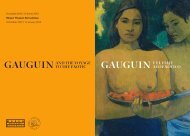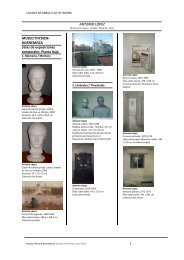EDWARD HOPPER - Museo Thyssen-Bornemisza
EDWARD HOPPER - Museo Thyssen-Bornemisza
EDWARD HOPPER - Museo Thyssen-Bornemisza
- No tags were found...
Create successful ePaper yourself
Turn your PDF publications into a flip-book with our unique Google optimized e-Paper software.
Hopper (Nyack, 1882 – New York, 1967) was one of thekey figures within 20 th -century realism although heworked for many years as an illustrator, totally ignoredby the general public and critics. He sold his first work,Sailing Boat (1911), in 1913 and the second, TheMansard Roof, to the Brooklyn Museum of Art in 1923. Itwas not until the following year, at the age of 43, thathe enjoyed the success of his first exhibition at the RehnGallery in New York and was thus able to devote himselffully to art. The Great Depression did not prevent majorAmerican museums and collectors from acquiring hiswork from this point onwards. In 1930 House by theRailroad (1925) was the first work to enter the futurecollection of the recently inaugurated MoMA in NewYork, donated by the celebrated collector StephenClark, one of the greatest champions of Hopper’s work.Three years later, in 1933, the Museum exhibited morethan 70 works in the first major retrospective of Hopper’s career with loans from all over America. Inthe space of less than a decade Hopper thus passed from being almost unknown to become one of themost highly esteemed living artists in the USA.Americanism and realism were key aspects of Hopper’s work from the outset and his paintings offereda faithful portrait of America at the time, focusing on its most modern aspects but without anyelement of idealisation and presenting reality in a simplified manner. While Hopper painted somelandscapes and outdoor scenes, most of his works are located in public places such as bars, hotels,stations and on trains. These are almost empty settings with pronounced contrasts of light and shadethat emphasise the solitude and drama of modern existence.1.The Early YearsFélix Vallotton. Femme cousant dans unintérieur, 1905. Ville de Troyes,Collections nationals Pierre et DeniseLevyEdward Hopper, House by the Railroad, 1925.The Museum of Modern Art, New York.Given anonymously, 1930In Robert Henri’s studio Hopper absorbed a modern realismthat represented a break from the prevailing academicism.His earliest works clearly reveal the relationship between hisart and the American tradition pursued by Henri and WinslowHomer, who portrayed early 20 th -century American society.In 1906 Hopper moved to Paris where he remained for almosta year and to where he would return on subsequentoccasions. Spending time in Paris was regarded as almostcompulsory for American artists from the mid-19 th centuryonwards. Contact with Impressionism laid the way for Hopperto develop a particular approach to light and sensuality thatwould become key characteristics of his work throughout hiscareer. In his works of this period he depicted the housewhere he lived on rue de Lille and its immediatesurroundings. These images are to be seen in the presentexhibition alongside others by the European artists whoinfluenced him such as Albert Marquet, Walter Sickert andFélix Vallotton.On his return to the USA, Hopper found himself obliged towork as an illustrator for professional publications and inadvertising, an activity he considered degrading but one that he tried to adapt to his artisticvocation. At this point he discovered the narrative potential of the image and also improved histechnique, both of which soon became evident in his painting. Many of the subjects on which hewould subsequently focus, such as leisure activities, popular spectacles and events and office life,have their direct precedents in the drawings that he produced for these publications although theresults were radically different: while his illustrations were positive images that appealed toconsumerism and which depicted enjoyable leisure activities, his canvases expressed the apathy,drama and solitude of the characters to be seen in them.
EXHIBITION INFORMATIONTitle: Edward HopperOrganisers: <strong>Museo</strong> <strong>Thyssen</strong>-<strong>Bornemisza</strong> and Rmn – Grand Palais (Paris)Dates and venues: Madrid, <strong>Museo</strong> <strong>Thyssen</strong>-<strong>Bornemisza</strong>, 12 June to 16 September 2012. Paris, Rmn –Grand Palais, 10 October 2012 to 28 January 2013Curators: Tomàs Llorens, Honorary Director of the <strong>Museo</strong> <strong>Thyssen</strong>-<strong>Bornemisza</strong>, and Didier Ottinger,Associate Director of the MNAM/Centre PompidouCoordinator: Leticia de Cos, Curatorial Department, <strong>Museo</strong> <strong>Thyssen</strong>-<strong>Bornemisza</strong>Number of works: 70 (approx.)Publications: catalogue, in SpanishParallel activities: International symposium, Edward Hopper, Film and Modern Life, 19 to 22 JuneVISITOR INFORMATION<strong>Museo</strong> <strong>Thyssen</strong>-<strong>Bornemisza</strong>:Address: <strong>Museo</strong> <strong>Thyssen</strong>-<strong>Bornemisza</strong>. Paseo del Prado 8, 28014, Madrid. www.museothyssen.orgOpening times: Tuesdays to Saturdays, 10am to 11pm. Mondays and Sundays, 10am to 7pm. Ticketdesks close half an hour before visitors must leave the galleriesTicket prices:Temporary exhibition:- General ticket: 10 Euros- Reduced price ticket: 6 Euros for visitors aged over 65, pensioners, students with proof ofstatus and Large Families- Free entry: children aged under 12 and officially unemployed Spanish citizensTemporary exhibition + Permanent Collection:- General ticket: 15 Euros- Reduced price ticket: 8 Euros- Free entry: children aged under 12 and officially unemployed Spanish citizensPre-booked tickets available at the Museum’s ticket desks, on its website and on tel: 902 760 511More information: www.museothyssen.orgAudioguide: available in various languagesPRESS INFORMATIONhttp://www.museothyssen.org/microsites/prensa/2012/Hopper/index.html
















